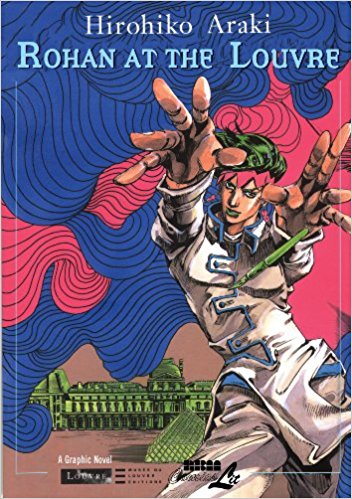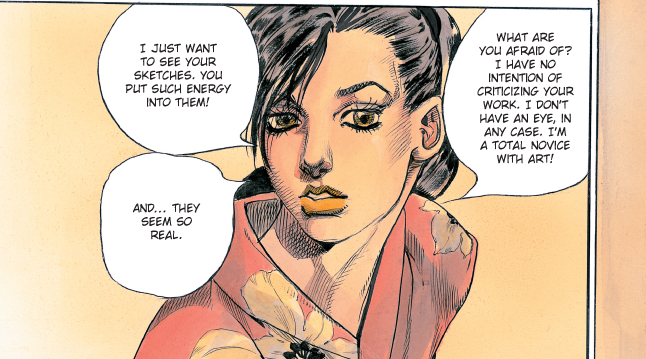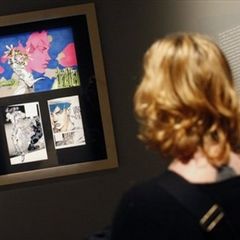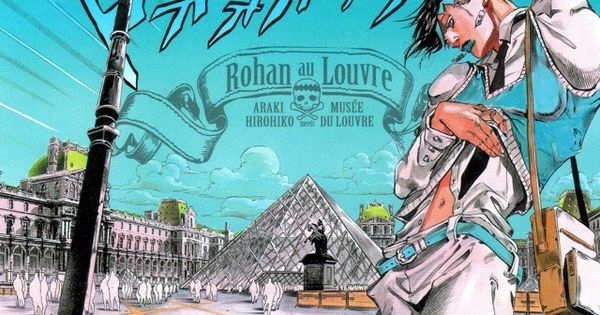 In 2009, the Louvre Museum, one of the most renowned art museums in the world, gathered comic book artists together for a unique exhibit showcasing the breadth of contemporary art found in comic books. French bandes dessinées and American comic books featured prominently in the display, joined by panels drawn by Japanese manga artist Hirohiko Araki. While most of the featured comics used the grounds of the Louvre as a vehicle for investigating art or even as characters, Araki took one of his more popular characters, a manga artist turned occult detective, and thrust him into a mystery deep inside the Louvre’s underground tunnels, complete with all the accumulated quirks of his JoJo’s Bizarre Adventure -and a touch of body horror.
In 2009, the Louvre Museum, one of the most renowned art museums in the world, gathered comic book artists together for a unique exhibit showcasing the breadth of contemporary art found in comic books. French bandes dessinées and American comic books featured prominently in the display, joined by panels drawn by Japanese manga artist Hirohiko Araki. While most of the featured comics used the grounds of the Louvre as a vehicle for investigating art or even as characters, Araki took one of his more popular characters, a manga artist turned occult detective, and thrust him into a mystery deep inside the Louvre’s underground tunnels, complete with all the accumulated quirks of his JoJo’s Bizarre Adventure -and a touch of body horror.
In many ways, Araki was the perfect choice for such a collection. JoJo’s Bizarre Adventure is rooted in both Japanese and Western pop culture, mixing Japanese punk brawlers with a love for Western music and the traditions of both cultures’ occult detective stories. The names of several characters may be familiar: Dio, Speedwagon, Red Hot Chili Pepper, Cream, Aerosmith, Green Day, Black Sabbath, etc.. The series is still going strong after thirty years, following the Joestar family throughout generations as they fight against an ancient and undead enemy of the family. To properly explain the JoJo’s series would easily require a month’s columns and the average reader might still think the plot and the setting a fever dream. Perhaps one way to think of the series is if the X-men fought each other with Pokemon, mutant powers, and their fists. And, strangely enough, it works so well that JoJo’s Bizarre Adventure has been a staple of manga readers throughout it’s entire run.
To overcome the daunting barrier of entry that such a long-lived series creates, Araki crafted his exhibit, collected in Rohan at the Louvre, to be a stripped-down version of a JoJo story. Focusing on Rohan Kishibe, the aforementioned manga artist turned occult investigator, Araki moves the powers and other regular JoJo characters to the background, allowing guests to the Louvre to experience this ghost story through his eyes. After a brief introduction to Rohan and his power to read people like books–illustrated with a touch of body horror as their skin peels like pages, Rohan tells his story of a search for the darkest black ever seen. And so begins a horror story worthy of mention in the same sentence as Manly Wade Wellman’s “The Golgotha Dancers”.
The tale proper begins when Rohan is seventeen, struggling to earn a job as a manga artist. He is frustrated because his editor tells him that his drawings of women are lifeless. When a 21-year-old soon-to-be-divorcee Nanase moves into his apartment building, Rohan grows fascinated with her, drawing her at every opportunity. Nanase catches him in mid-sketch, and confronts him. Rohan’s explanation charms her, and Nanase’s piqued interest in Rohan’s art over time turns into romance. During one of their evenings together, Nanase mentions a mysterious painting of exquisite blackness in the Louvre. But the days of the happy couple are short, as when Nanase discovers her portrait in Rohan’s manga, she shreds the drawings and flees into the night.

Ten years later, a stray comment sparks Rohan’s memory, and he travels to the Louvre to find the mysterious painting. What should have been a denied request quickly turns into a search of the Louvre’s catacombs. Escorted by two firemen, a curator, and a translator, Rohan is taken to a storage tunnel empty of everything except for the dark painting. The search becomes lethal, as, one by one, the people around Rohan die in grisly ways as the ghosts of their ancestors display their wrath. Then, when Rohan is alone, he sees Nanase among the ghosts…
 Written at a time when many of the more regrettable anime and manga tropes were being codified, Araki instead chooses to write against trope to make statements about art. When arriving at the Louvre, Rohan chastises his fans, telling them show some respect when visiting the masterworks of grand masters. At least wear a tie. But the real differences shine through when Rohan is seventeen. He is not the first nor the last seventeen year old manga artist to grace the pages of a comic book. But where many of his contemporaries played the role of the ascended fan, enthusiasts of pop culture media, Rohan instead focuses on the beauty of art itself. Rather than copy current fashions in manga, he draws from his own experiences and observations. And most importantly, his art attracts women instead of repelling them, unlike those characters who celebrate fandom before art. Rohan embodies the tropes of the struggling artist instead of the stereotypical manga artist, and thus he can show the power of his art through his romance with Nanase. Instead of a message, Araki celebrates the life behind art, a timeless subject worthy of inclusion in the Louvre. But when it’s time to set aside the conceits of arts for the demands of story, Rohan at the Louvre becomes a ghost story worthy of The Unique Magazine.
Written at a time when many of the more regrettable anime and manga tropes were being codified, Araki instead chooses to write against trope to make statements about art. When arriving at the Louvre, Rohan chastises his fans, telling them show some respect when visiting the masterworks of grand masters. At least wear a tie. But the real differences shine through when Rohan is seventeen. He is not the first nor the last seventeen year old manga artist to grace the pages of a comic book. But where many of his contemporaries played the role of the ascended fan, enthusiasts of pop culture media, Rohan instead focuses on the beauty of art itself. Rather than copy current fashions in manga, he draws from his own experiences and observations. And most importantly, his art attracts women instead of repelling them, unlike those characters who celebrate fandom before art. Rohan embodies the tropes of the struggling artist instead of the stereotypical manga artist, and thus he can show the power of his art through his romance with Nanase. Instead of a message, Araki celebrates the life behind art, a timeless subject worthy of inclusion in the Louvre. But when it’s time to set aside the conceits of arts for the demands of story, Rohan at the Louvre becomes a ghost story worthy of The Unique Magazine.
The character design in Rohan at the Louvre is straight JoJo, stylized, muscular, yet more realistic than many of Araki’s peers. The clothes, hair, and colors are trendy, if now a bit dated, and the fascination with florescent and paste hues seen on the covers of JoJo is carried throughout the full-color manga. If Rohan looks a bit slender and slim, he is supposed to as a contrast with the beefy punks of JoJo. After months of reading vivid four-color bandes dessinées, with stunning reds and blues, the shift to a palette of magenta, cyan, and sea green is jarring, but adds to the sense of fashion surrounding the tale. It also serves to heighten the body horror to come. The backgrounds are simple, evoking memories of walking the Louvre when in the galleries. In the tunnels, the claustrophobic shelves and shadows heighten the growing anticipation of terror.
I’ve often said that the spirit of Poe and the pulps lives on in Japan. Recent forays into the direct descendants of the pulps, light novels, have proven wanting as slice of life replaced adventure and the unknown. But Rohan at the Louvre delivers on the adventure, the romance, and the fear of the unknown seen in the heyday of pulp fiction. It’s manga without the cringe I’ve come to expect in recent works, and a perfect addition to the Louvre Collection. I freely recommend this to any comic book and pulp enthusiast, not just fans of JoJo’s Bizarre Adventure and of manga in general.

Part IV, the one Rohan comes from, is mainly a series of Weird Tales one after the other. It’s the usual JoJo craziness with action and adventure with a dab of horror, but that touch of wonder and mystery is all over Morioh.
It’s no coincidence that it’s my favorite part.